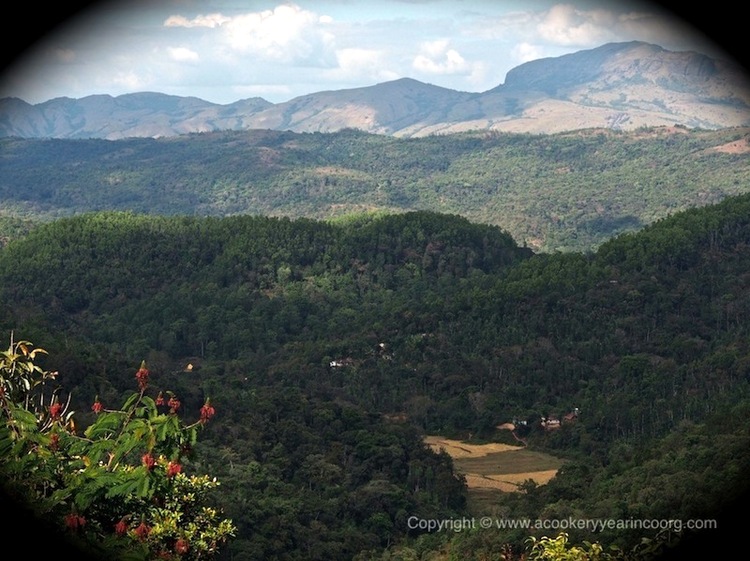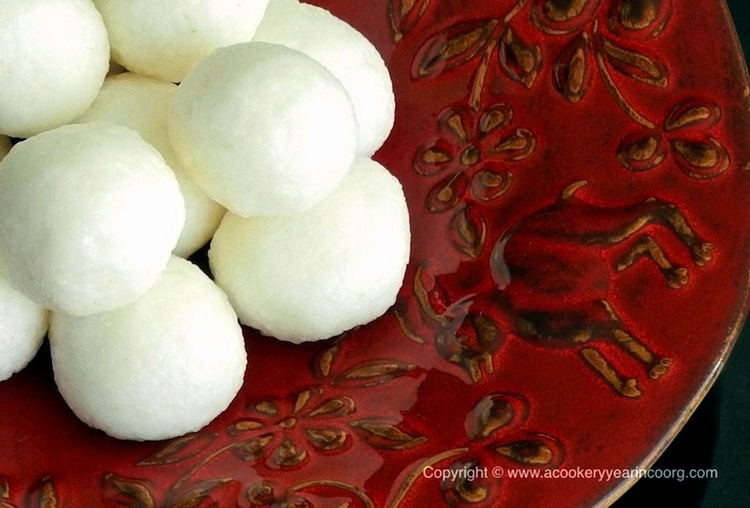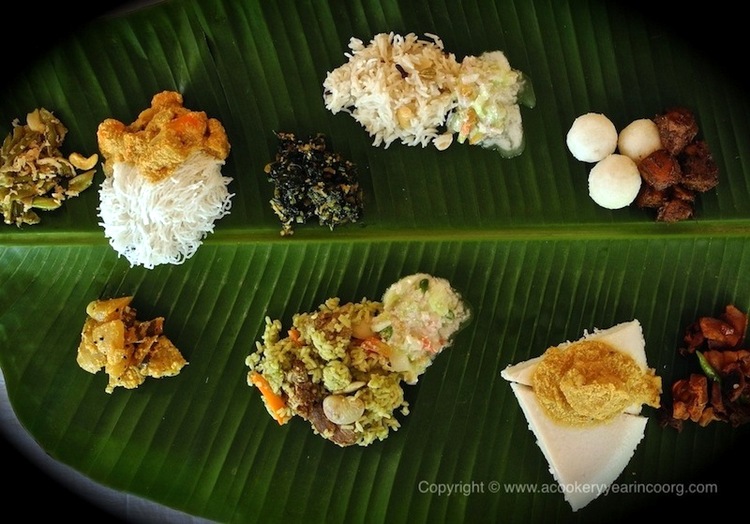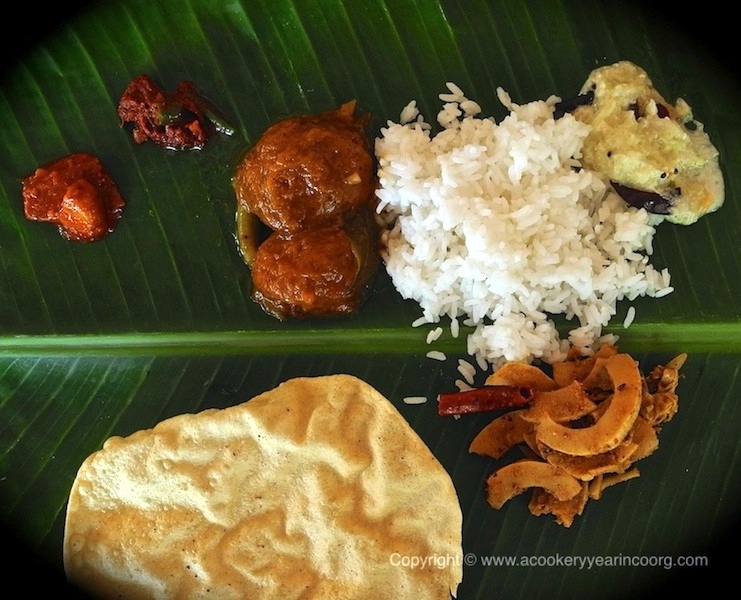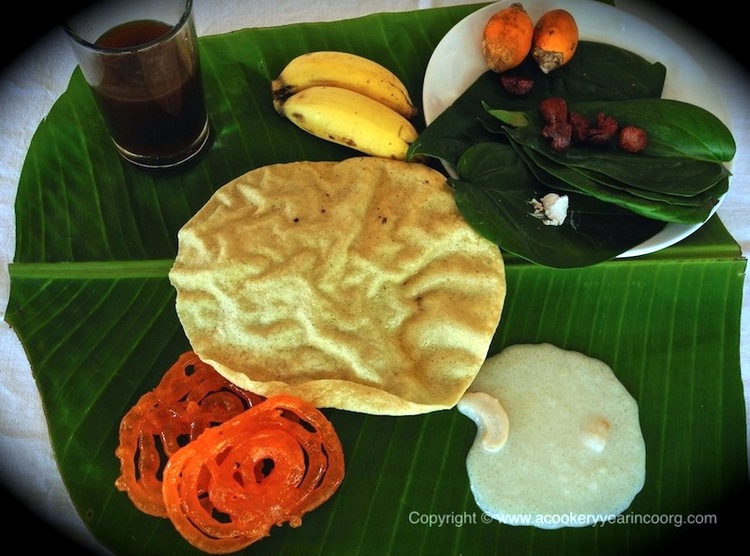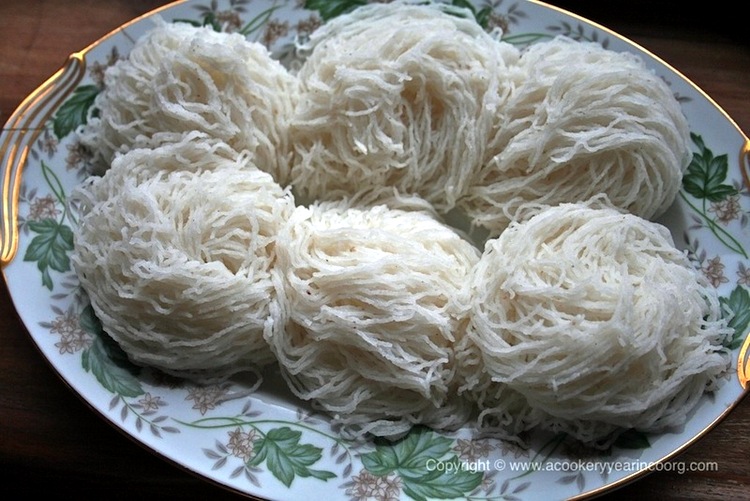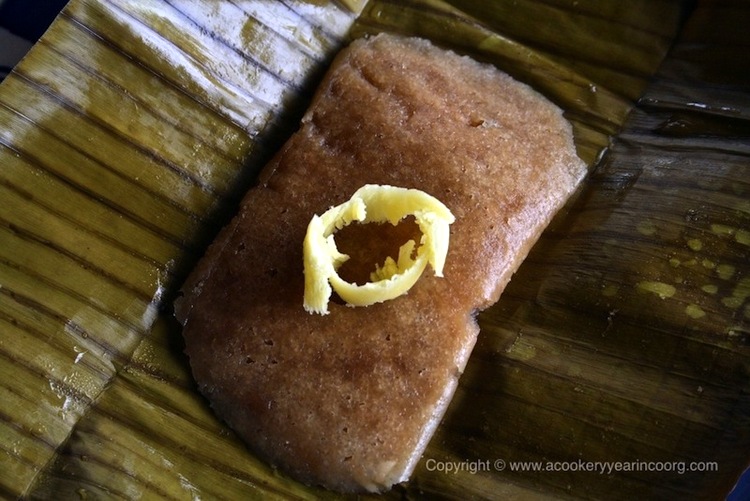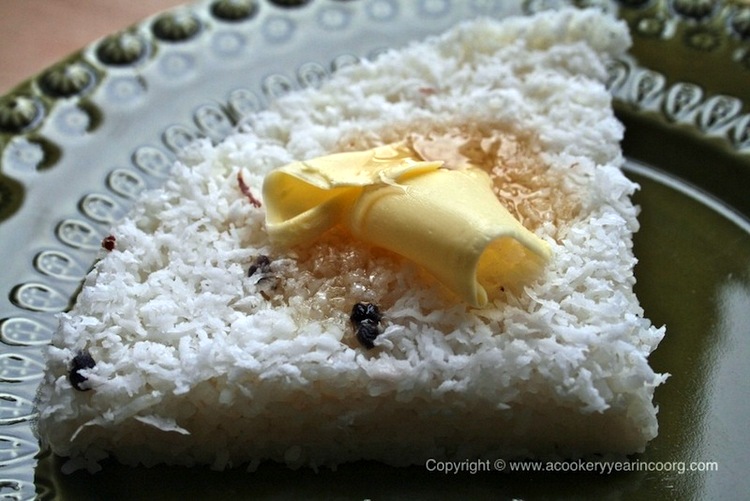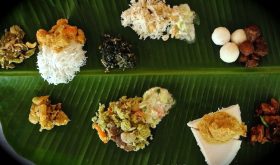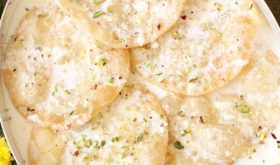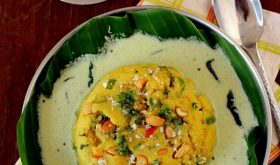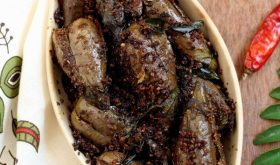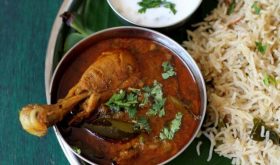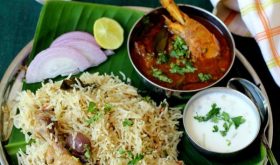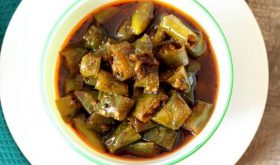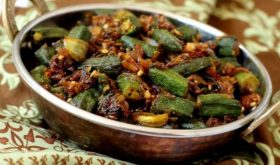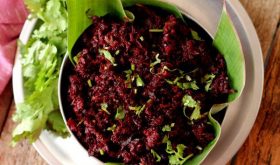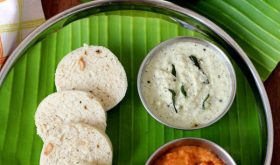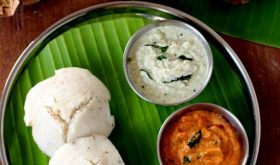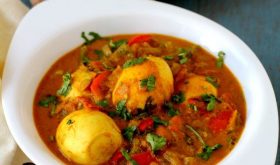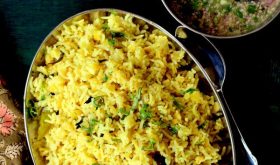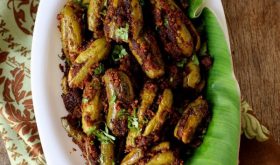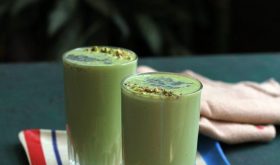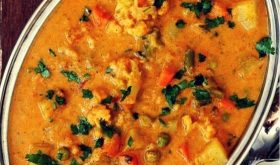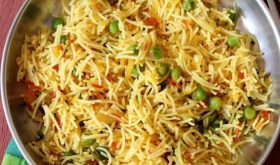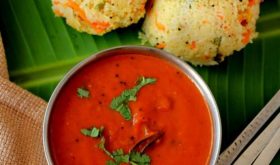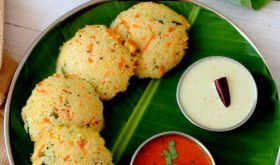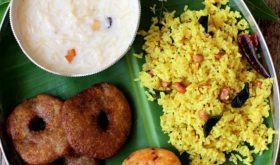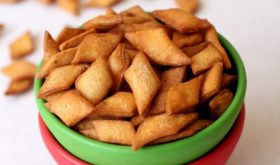Kodava Cuisine
Indian Food Trail is on a trip down South to the picturesque Kodagu aka Coorg (known as Scotland of India). I have holidayed at this beautiful hill station and was fortunate to witness first hand the rich culture and traditions of the Kodava people who are very warm, affectionate and hospitable folks and love good food. 🙂
Shalini, a food blogger from Kodagu, is very passionate about her food culture and has taken the pain to dig deep into the history of the culinary habits of Kodava people. She is based in Vancouver and runs a lovely food blog – A Cookery Year in Coorg where she introduces us to the Kodava culinary traditions through well researched articles and family recipes. Shalini is fortunate to have access to many of the ingredients to recreate traditional Kodava fare and delights in finding interesting substitutes in the local produce of Canada and US.
Today, she shares with us the Kodava food culture as well as a traditional Kodava recipe, Paputtu. Do visit her lovely food blog to learn more about Kodava food and recipes that are sure to salivate your taste buds. Dear readers, please give a warm welcome to Shalini.
~Sailaja
A Taste of Kodava Cuisine (Coorg Food)
Thank you, Sailaja, for inviting me to do this guest post. Your blog has been a source of much culinary delight in my home, over the years, and I’m glad of an opportunity to try and reciprocate in some small measure. I’ve also enjoyed the previous entries on the Indian Food Trail thoroughly, and learnt a lot from these amazingly talented bloggers.
Before I begin, I’d like to direct your readers to www.coorgrecipes.com, to “An introduction to Coorg Cuisine” for a concise, and entertaining, introduction to Kodava Cuisine. The website was launched in 2007 by senior journalist P.T. Bopanna, author of several books on various aspects of Coorg and Kodava culture. This is Mr. Bopanna’s attempt to compile traditional Kodava recipes, as well as not so traditional but popular favourites, and make them accessible to readers around the world. I am happy to contribute, in my own way, to this effort to share our culinary traditions (and innovations!).
I must confess that Sailaja’s request for a post with special emphasis on a Kodava “thali” had me slightly flummoxed. Most traditional Kodava meals tend to be very simple. If I chose to describe a classic breakfast of akki otti (rice flatbreads) with kumbala (pumpkin) curry, ellu pajji (sesame chutney) and coffee, there’d be substance to that. But then what of all those other foods of our Kodava cuisine that are eaten in favourite combinations, and those that are associated with special ceremonies, festivals and most of all, the seasons? What was I to choose?
A little peek at the lay of the land might help put things in perspective. In the picture below, you’ll get an idea of what a typical Kodava homestead might have looked like, historically speaking. Set on the edge of paddy fields, surrounded by tree covered hills, and picture postcard pretty.
If you replace those orderly rows of trees and manicured coffee estates with dense forests, teeming with wildlife, the picture changes. While access to the plains of Mysore, or the coasts of Kerala or Mangalore, all relatively close, did allow for some exchange of produce, it was hardly an easy excursion and journeys were often fraught with danger. There was nothing remotely like the steady supply of provisions we take for granted today. People living here would have, for the most part, been reliant on what produce they could grow on the land and gather from the surrounding forests, and this was reflected in the local Kodava cuisine.
Living in such close proximity with nature is constantly challenging, and for an idea of what life in a remote village in Coorg might have been like in the early years of the last century, do read this interview with former president of the Karnataka Kodava Sahithya Academy, Professor Appanna.
We often forget in modern day life, with all sorts of conveniences at our fingertips, that in order to survive, people needed to be hardy, practical and acutely tuned to and respectful of everything the land had to offer. While this would hold true for life virtually anywhere at the time, spending a monsoon season in Coorg even now should be enough to convince you of just what a challenge it must have been to people living here. But survive, and thrive, they did! With an innate love for living well and good eating, the Kodavas’ culinary repertoire happily embraced eclectic influences and continues to grow.
So, back to the question of a Kodava thali, I finally settled on a wedding feast in order to be able to present as many items as possible. That being said, the concept of a traditional wedding feast has also undergone changes with time. Today, the sit-down feasts cooked by traditional “wedding cooks” and served to guests by family members are rare. Weddings tend to be catered by hotels and restaurants, and the menus, while incorporating the traditional favourites like pandi curry and kadambuttu, can include pan-Indian, European, Chinese, or Thai preparations. Anything the hosts fancy, really!
According to Professor Appanna, in the average Naad (village) wedding circa 1940’s-50’s, a typical wedding menu would have been fairly limited. Before the wedding, the family might hold a hunt (which is no longer an option, of course). Wild boar or venison would be cooked and served to guests as part of the feast. An average menu might consist of “kadambuttu, pandi curry, wild boar/venison, chicken for the ones who didn’t eat game or pork, plain rice,and two kinds of vegetable preparations. The meal would end with a payasa, black coffee with jaggery, and bananas.”
He says that with increasing prosperity, by the 1960′-70’s wedding menus became more elaborate, incorporating additional courses with ghee rice or pulao, and more items in general.
It’s been many years since I last sat down to a traditionally cooked and served Kodava wedding feast, and I admit to being rather nostalgic. Here’s a look at some of the traditional Kodava cuisine favourites that might have appeared at a wedding.
Top row, left to right: beans barthad (sautéed beans), nuuputtu with kootu curry (mixed vegetable curry), thoppu (greens) palya, neyi koolu (ghee rice) and chowté pajji (cucumber raita), kadambuttu and pandi curry
Bottom row, l to r: bollari barthad (sautéed Mangalore cucumber) mutton pulao with kaipuli pajji (citrus in a spiced yogurt base), thalia puttu (steamed rice and lentil cake) and koli (chicken) curry, chilli pork (in lieu of game meat!)
Top row, l to r: lime pickle, fish pickle, kaad maangé curry (wild mango curry), rice, chowté pajji
Bottom row, l to r: papad and baimbalé barthad (sautéed bamboo shoot)
A sweet finish
Top row, l to r: bella kapi (black coffee with jaggery), bananas, betel leaves, areca nuts with lime paste
Bottom row, l to r: jalebis (a very popular sweet!) and thari payasa (dessert made from sweetened milk and broken rice)
My grateful thanks to B A Devaiah, who runs the beautiful resort “Capitol Village” outside Madikeri, for his generosity and effort in recreating this wedding spread. Devaiah says that his father told him it was also once customary to place cigarettes, or beedis along with the betel nut plate, for departing guests!
You will find recipes for all these dishes and variations on www.coorgrecipes.com.
Rice really is the heart of Kodava cuisine and is processed and cooked in an astonishing number of ways into the perfect foils for the foods that the changing seasons bring. From the hearty akki otti (rice flatbread), to the ethereal oduputtu, scented with “banda†(resin of the Indian copal tree, Vateria indica) the creativity and ingenuity of generations of cooks shines through.
For Sailaja’s readers, I suggest a simple way to approach Kodava cuisine would be to first explore the many delicious rice based preparations which will happily settle into vegetarian and non-vegetarian households! Akki otti, kadambuttu, nuputtu, kulae puttu, the rather unusual thambuttu – you’ll find step-by-step recipes for all these on A Cookery Year in Coorg.
I’d like to share one of my personal favourites, paputtu, here where the main ingredient is thari:
Equipment
•You will need small thalis with raised rims, or dhokla plates. Do try and find some plates with reasonable depth – paputtu is best in thick slices.
•A sekala, idli steamer or a pressure cooker wide enough to accommodate the plates you are using. If using the latter, steam without the weight on.
•A bamboo steamer will work too, but you may need to increase the cooking time by 10 to 15 minutes.
•Flat wooden sticks to separate the plates when stacking in the sekala. Improvise with anything that provides a stable base for the plates to rest on and that doesn’t restrict the flow of steam.
Thank you again, Sailaja, for this opportunity to share this sampling of Kodava cuisine with your readers. I do hope they’ve enjoyed it!
~Shalini
Listed below are guest posts on different Indian regional cuisines by fellow food bloggers.
Maharastra
A Simple Summer Meal by Nupur of One Hot Stove
Traditional Maharashtrian Thalis – Veg & Non-Veg by Meera of Enjoy Indian Food
Traditional Maharastrian Sweet & Snacks by Meera of Enjoy Indian Food
Konkan Region – North Canara
An Essay on Konkani Cuisine by Shilpa of Aayis Recipes
Kerala
Munchies from a Kerala home – Shn of Mishmash
A traditional Malabar meal ~ Shaheen of Malabar Spice
Udupi-Mangalore
Exploring Udupi Mangalorean Street Foods by Sia of Monsoon Spice
Mangalore
Mangalore Cuisine, Mangalore Recipes and Mangalorean Catholic Cuisine by Shireen of Ruchik Randhap
Mysore
Mysore Cuisine, by Vani of Mysoorean
Tamil Nadu
Traditional Tamil Tiffins – Lakshmi of Veggie Cuisine
Bengal
Bengali Cuisine ~ Sandeepa of Bong Mom’s Cook Book
Hyderabad
Hyderabadi Cuisine ~ Mona of Zaiqa
Kongu
Kongu Cuisine ~ Indhu of Daily Musings
Khandesh
Khandeshi Cusine – Minoti of Vadani Kaval Gheta
Sindhi
Sindhi Cuisine – Alka of Sindhi Rasoi
